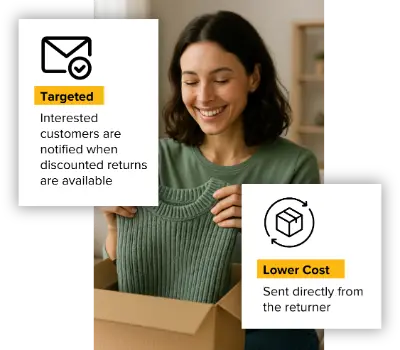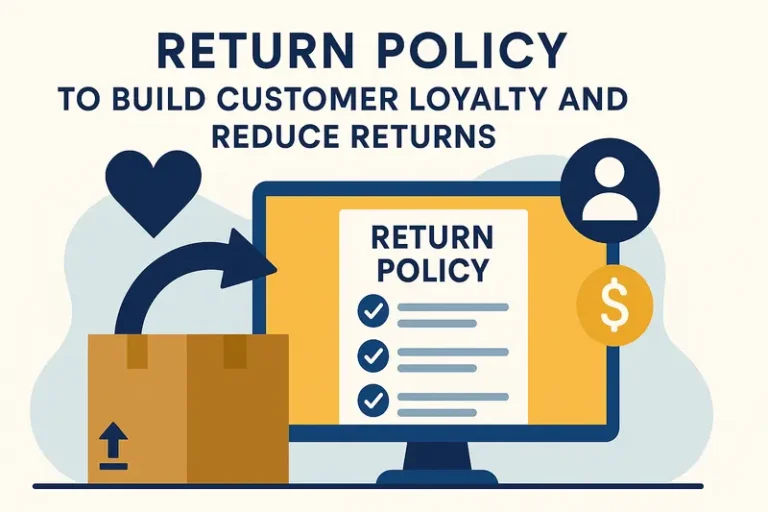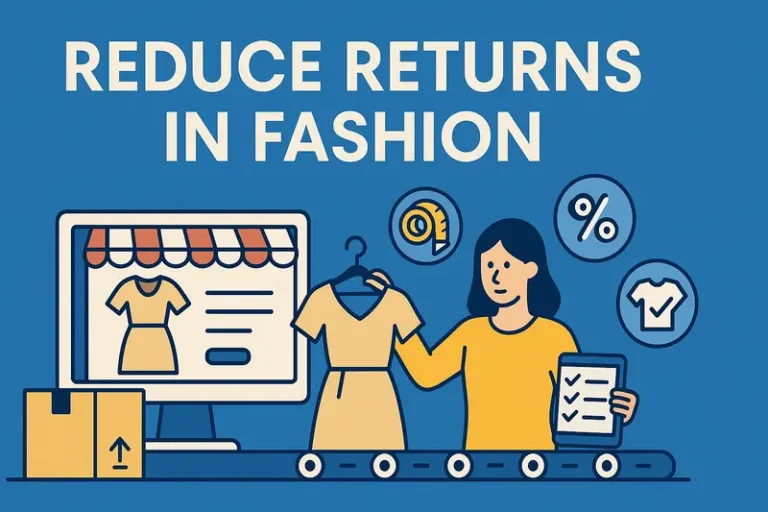Lessons from Top Ecommerce Brands to Improve Ecommerce Return Experiences

Last updated on April 28, 2025

In this article
 12 minutes
12 minutes
- Why Returns Matter in Ecommerce
- Top Ecommerce Brands That Get Returns Right
- How to Improve Your Own Return Experience: Key Takeaways
- Streamlining Returns with Prepaid Return Labels
- Analyzing Return Data
- Protecting Against Ecommerce Return Fraud
- Sustainable Returns Practices
- Summary
- Frequently Asked Questions
The return processes are a critical component of customer satisfaction in ecommerce. In a highly competitive online market, the way ecommerce brands handle returns can significantly impact customer satisfaction and ultimately determine whether a customer returns for future purchases. Whether it’s the ease of the return process, offering free return shipping, or managing return shipping costs, a seamless return experience can elevate the entire customer experience.
In this article, we’ll explore valuable lessons learned from top ecommerce brands that have successfully crafted hassle-free return experiences. We’ll dive into the strategies that help improve customer loyalty, reduce return rates, and enhance profit margins by optimizing the returns management process.
Why Returns Matter in Ecommerce
Before we explore the lessons from leading brands, it’s essential to understand why returns matter so much in the context of ecommerce. For many online retailers, the associated costs of returns are a significant consideration. According to the National Retail Federation, the average ecommerce return rate in the U.S. is estimated to be over 20%, much higher than in brick-and-mortar stores. While this is an inevitable part of online shopping, the way ecommerce businesses manage this process can either make or break their customer retention efforts.
Ecommerce returns are not just a logistical issue; they’re also a customer service issue. A poor return experience, including delays in processing returns, can lead to customer dissatisfaction, negative reviews, and a decline in brand reputation. On the other hand, a smooth return process can boost customer satisfaction, enhance customer loyalty, and even encourage repeat purchases.
Make Returns Profitable, Yes!
Cut shipping and processing costs by 70% with our patented peer-to-peer returns solution. 4x faster than traditional returns.
See How It WorksTop Ecommerce Brands That Get Returns Right
1. Zappos: The Power of No-Questions-Asked Returns
Zappos is perhaps the most well-known ecommerce brand for offering a customer-friendly return experience. The company’s policy of offering 365-day returns with free return shipping is a game-changer. This generous return window and the no-questions-asked approach to returns have made Zappos a customer loyalty powerhouse.
Why it works: Zappos focuses on customer satisfaction by prioritizing customer convenience. The ease with which customers can process returns, whether in-store or online, creates a positive post-purchase experience and significantly boosts customer loyalty. By offering a full refund, cash refunds, or store credit, Zappos ensures customers are happy, regardless of the reason for their return.
Key takeaway: A no-questions-asked return policy helps build customer loyalty, reduce buyer’s remorse, and encourages customers to make future purchases, knowing they won’t be stuck with a product they don’t love.
2. Amazon: Streamlining the Returns Process with Technology
As one of the largest and most successful ecommerce businesses, Amazon has perfected its returns management process. Amazon offers a seamless returns portal, allowing customers to initiate returns with just a few clicks. It integrates return shipping labels with Amazon Prime for free return shipping, streamlining the entire returns process.
Why it works: Amazon leverages technology, data analytics, and effective inventory management to offer an optimized, personalized experience for customers. Customers are not only informed about the status of their returns but also receive real-time updates on the progress of their return. This transparency significantly improves the customer experience and fosters customer loyalty.
Key takeaway: Leveraging technology like automated returns portals and providing free return shipping creates a smooth and transparent returns experience, helping ecommerce businesses stay ahead of the competition.
3. Nordstrom: Combining Excellent Customer Service with Efficient Returns
Nordstrom, a brand that excels both in ecommerce and brick-and-mortar stores, is known for providing excellent customer service during the returns process. Their return policy is generous, offering a hassle-free return experience with no specific time limit. Nordstrom goes above and beyond by enabling customers to return online purchases in-store, offering a level of convenience and flexibility that few competitors match.
Why it works: Nordstrom recognizes that returns are an extension of the customer service experience. By integrating their in-store returns with their ecommerce operations, they make the returns process easier and more customer-centric. In-store returns also benefit Nordstrom by driving foot traffic into physical locations, encouraging future purchases.
Key takeaway: Offering in-store returns for online purchases provides an easy and convenient returns process that meets customer expectations while also creating opportunities for increased sales and customer engagement.
4. ASOS: Mastering International Returns with Localized Solutions
For global ecommerce brands, managing cross-border returns can be tricky due to different customs regulations, shipping costs, and local return policies. ASOS, a leading online fashion retailer, has developed a highly efficient system for managing international returns. By providing return shipping labels and localized return hubs in different countries, ASOS makes it easier for international customers to return items without incurring high costs.
Why it works: By offering free return shipping for defective or unwanted items in specific regions, ASOS removes barriers to return and ensures customer satisfaction for its global base of customers. This system also reduces the logistics costs typically associated with cross-border returns, positively impacting supply chain operations.
Key takeaway: For international ecommerce, providing localized return solutions and integrating return hubs reduces return shipping costs and makes the return process more accessible and affordable for global customers.
Convert Returns Into New Sales and Profits
Our peer-to-peer returns system instantly resells returned items—no warehouse processing, and get paid before you refund.
I'm Interested in Peer-to-Peer ReturnsHow to Improve Your Own Return Experience: Key Takeaways
1. Set Clear Return Expectations
One of the most critical elements of an effective return process is a clear and accessible returns policy. Customers want to know exactly how long they have to return a product, the condition it must be in, and whether they will receive a full refund or store credit. Be transparent about your return window, return shipping fees, and restocking fees.
- Include clear, simple language in your return policy.
- Provide easy-to-access links to your returns portal.
- Offer free return shipping if feasible or provide prepaid return labels to lower the barrier for returns.
2. Provide Multiple Return Options
Customers are increasingly seeking flexibility in the return process, and giving customers multiple return options can significantly enhance their experience. Offering multiple return options, such as free return shipping, local drop-off points, or in-store returns, can improve customer satisfaction and reduce friction.
- Use self-service return portals where customers can initiate returns at their convenience.
- Partner with local retailers or service providers to offer easy drop-off points for returns.
3. Leverage Technology for Streamlined Processes
Using technology to streamline the reverse logistics process reduces manual effort and increases efficiency. Implementing returns management systems helps track returns, manage inventory, and offer real-time updates to customers.
- Use automated return approval systems to expedite returns.
- Integrate AI-powered solutions to detect return fraud and streamline logistics.
- Offer a self-service return portal where customers can track returns and manage exchanges or refunds.
4. Make the Return Process Part of the Customer Journey
Transform the return process from a negative experience into an opportunity for customer engagement by accommodating customers’ preferences. Offer customers incentives for exchanges instead of refunds, and promote store credit as an alternative to full refunds.
- Use customer feedback from returns to improve product offerings and address common issues (e.g., sizing).
- Incorporate loyalty rewards for customers who opt for exchanges or store credit instead of returning for a refund.
5. Offer a No-Hassle Experience
When customers feel that returning an item is part of a smooth returns process, it boosts their overall customer experience. Make it simple for them to process returns, whether that means providing prepaid return labels or ensuring fast, easy access to your return portal.
Streamlining Returns with Prepaid Return Labels
Prepaid return labels can substantially improve the return process for both customers and ecommerce businesses. By providing prepaid return labels, businesses make it incredibly easy for customers to send back items, eliminating the hassle of figuring out return shipping costs. This convenience can significantly boost customer satisfaction, as customers appreciate knowing there’s no cost for return shipping upfront.
For ecommerce businesses, prepaid return labels reduce the number of customer support queries related to return shipping, freeing up the customer service team to handle more complex issues. Additionally, integrating prepaid return labels into the returns portal allows customers to print or download their return labels instantly, making the entire returns process more streamlined and efficient.
By simplifying the return process with prepaid return labels, ecommerce businesses can enhance the overall customer experience, reduce operational complexities, and foster greater customer loyalty.
Analyzing Return Data
Analyzing return data is a crucial practice for ecommerce businesses aiming to understand the reasons behind returns and identify areas for improvement. By delving into return data, businesses can gain valuable insights into customer preferences and expectations, enabling them to make informed, data-driven decisions.
Return data can reveal trends and patterns, such as common reasons for returns or specific products that are frequently returned. This information allows businesses to address issues proactively, whether it’s improving product descriptions, adjusting sizing charts, or enhancing product quality.
Moreover, analyzing return data helps measure the effectiveness of the returns process, identifying bottlenecks and areas where improvements can be made. By leveraging return data, ecommerce companies can reduce return rates, enhance customer satisfaction, and build stronger customer loyalty.
Protecting Against Ecommerce Return Fraud
Ecommerce return fraud can significantly impact customer satisfaction and profit margins, making it essential for businesses to implement robust protection measures. A clear and comprehensive return policy that outlines the conditions for returns is the first line of defense against return fraud.
In addition to a well-defined return policy, ecommerce businesses can utilize technology, such as AI-powered return analysis tools, to detect and prevent fraudulent activities. Implementing a system to track and monitor return requests can help identify suspicious patterns and prevent fraudulent returns, thereby reducing financial losses.
No More Return Waste
Help the planet and your profits—our award-winning returns tech reduces landfill waste and recycles value. Real savings, No greenwashing!
Learn About Sustainable ReturnsSustainable Returns Practices
Sustainable returns practices are becoming increasingly important for ecommerce businesses looking to reduce their environmental impact and improve customer satisfaction. By using eco-friendly packaging materials and encouraging customers to return items in their original packaging, businesses can significantly reduce waste.
Offering incentives, such as bonus credit or free return shipping, to customers who participate in sustainable returns practices can further promote eco-friendly behavior. Implementing a closed-loop returns system, where returned items are resold or reused, helps reduce waste and enhances sustainability.
Adopting sustainable returns practices not only reduces the environmental impact but also improves customer satisfaction and builds a positive brand reputation. Customers are more likely to support businesses that demonstrate a commitment to sustainability, leading to increased customer loyalty and greater customer lifetime value (CLV).
Summary
Indeed, the ecommerce returns process has become a central aspect of the customer experience. How businesses manage returns can have a direct impact on customer satisfaction, customer loyalty, and ultimately, revenue retention. Top ecommerce brands such as Zappos, Amazon, Nordstrom, and ASOS have set exemplary standards for seamless return experiences, and there’s much to be learned from their approaches.
The key takeaways from these successful brands highlight the importance of clear return expectations, offering multiple return options, leveraging technology to automate returns, and providing customer-centric solutions like store credit and exchanges. By focusing on improving the returns journey, businesses can boost customer loyalty, reduce return rates, and optimize their returns management process to enhance both profit margins and operational efficiency.
As we move forward, ecommerce businesses must continue to innovate and adapt their return policies to meet customer expectations while maintaining profitability. Streamlining the returns process with prepaid return labels, automated systems, and robust fraud protection will not only make returns easier for customers but also help businesses retain more revenue from returned items.
Finally, adopting sustainable returns practices and using data analytics to assess return trends will improve both the environmental footprint and customer experience, fostering long-term customer loyalty and increased customer lifetime value (CLV). By taking the lessons from top ecommerce brands and incorporating them into your own returns management system, your business can stay ahead and turn returns from a pain point into an opportunity for growth.
Frequently Asked Questions
1. What are the most important elements of a customer-friendly return policy?
A customer-friendly return policy for ecommerce stores should include clear return guidelines, flexible return methods (like store credit or exchanges), and a simple, easy-to-understand process. It should be transparent about return windows and whether return shipping is included.
2. How can offering store credit help reduce return rates?
Offering store credit rather than a full refund helps businesses keep the value of returned products within the system. It encourages customers to make future purchases, thereby reducing the financial impact of returns and promoting customer loyalty. Additionally, businesses can encourage customers to opt for alternative return methods, such as exchanges or store credits, by implementing incentives like prepaid labels or bonus credit.
3. How can technology improve the returns process?
Technology like returns management software, AI-powered fraud detection, and self-service return portals streamlines the returns process by automating tasks, reducing manual errors, and keeping customers informed with real-time updates on their return status.
4. What role does customer service play in improving returns?
A helpful and knowledgeable customer service team can significantly improve the return experience and create loyal customers. By assisting customers promptly, addressing concerns, and offering personalized solutions, customer support can help retain customers and turn a potentially negative experience into a positive one.
5. How do I handle international returns efficiently?
To manage international returns and handle reverse logistics efficiently, offer localized return hubs, provide prepaid return labels, and make the returns process transparent. This reduces return shipping costs and complex customs procedures, improving customer satisfaction and reducing friction for global customers.

Turn Returns Into New Revenue





